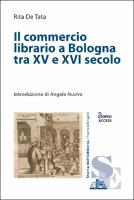Il commercio librario a Bologna tra XV e XVI secolo
| dc.contributor.author | De Tata, Rita | |
| dc.date.accessioned | 2022-03-03T11:39:03Z | |
| dc.date.available | 2022-03-03T11:39:03Z | |
| dc.date.issued | 2021 | |
| dc.identifier | ONIX_20220303_9788835112693_14 | |
| dc.identifier | ONIX_20220303_9788835112693_14 | |
| dc.identifier | OCN: 1371763780 | |
| dc.identifier.uri | https://library.oapen.org/handle/20.500.12657/53218 | |
| dc.language | Italian | |
| dc.relation.ispartofseries | Studi e ricerche di storia dell’editoria | |
| dc.subject.classification | thema EDItEUR::N History and Archaeology | en_US |
| dc.subject.classification | thema EDItEUR::3 Time period qualifiers::3M c 1500 onwards to present day | en_US |
| dc.subject.other | Early Modern History, Book History, XVIth century, Bologna History, XVIth century, Early Modern Italy, Early Modern Book Trade, XVIth century Bologna, History of Printing and Publishing | |
| dc.title | Il commercio librario a Bologna tra XV e XVI secolo | |
| dc.type | book | |
| oapen.abstract.otherlanguage | Fifteenth-century Bologna is one of the major Italian cities, home to a prestigious university and thriving industrial and economic center; in these conditions, ideal for the development of the early typographic art, the market of the manuscript book, with its world of copyists, illuminators, bookbinders, stationaries, soon adapts to the new way of production, fostering between XV and XVI century the emergence of some great families of booksellers-printers-publishers. Since the first decades of the sixteenth century, however, an overwhelming foreign book production is increasingly present on bolognese market: important printers like Vincenzo Valgrisi and Gabriele Giolito establish branches in the city, while in the law book sector the Lyonese publishing industry of Giunti is gaining momentum. The situation changes again in the second half of the century, when the market is remodeled following the conditioning by the ecclesiastical authorities and it extends to social strata previously excluded from cultural consumption. The work, which is based on a detailed investigation of the documentary sources, reconstructs for the first time a social history of the Bolognese book trade, both outlining the events of families and shops operating in the city, and opening the look at the relationships with the large foreign firms. | |
| oapen.relation.isPublishedBy | e2ddfb5e-9202-4851-8afe-1e09b020b018 | |
| oapen.relation.isFundedBy | 44d428b0-5533-497e-9aeb-a3765c6d2ab2 | |
| oapen.pages | 290 | |
| oapen.place.publication | Milan | |
| oapen.grant.number | [grantnumber unknown] |

